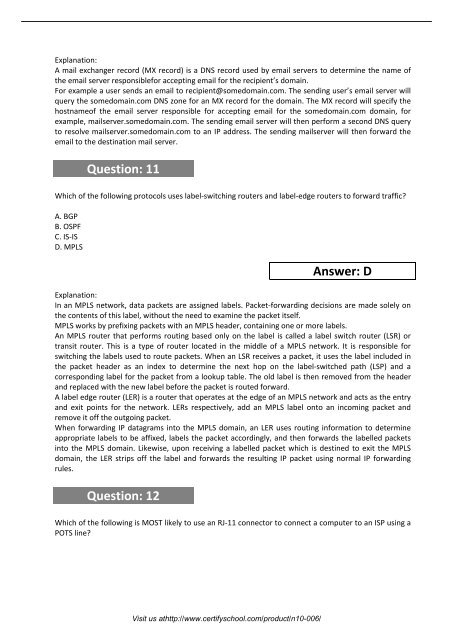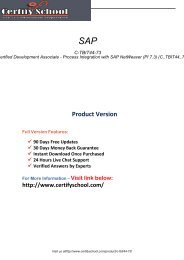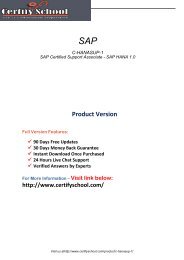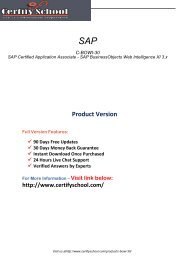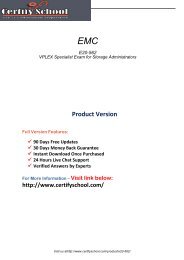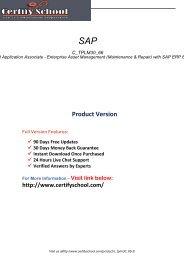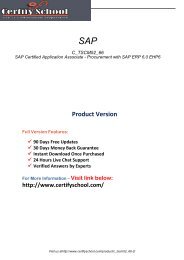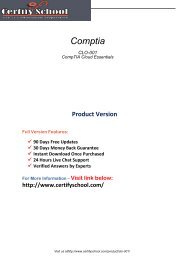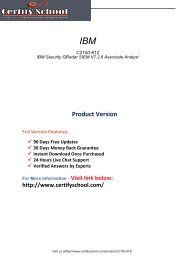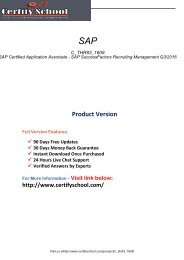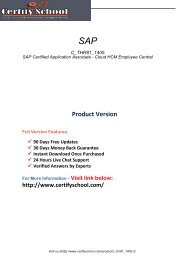N10-006 Latest Certification
Provided study material for N10-006 Certification Test is created and checked by authorized persons of relevant industry. You can use this PDF training kits to pass your exam. For more info please visit here: http://www.certifyschool.com/product/N10-006/
Provided study material for N10-006 Certification Test is created and checked by authorized persons of relevant industry. You can use this PDF training kits to pass your exam. For more info please visit here: http://www.certifyschool.com/product/N10-006/
Create successful ePaper yourself
Turn your PDF publications into a flip-book with our unique Google optimized e-Paper software.
Explanation:<br />
A mail exchanger record (MX record) is a DNS record used by email servers to determine the name of<br />
the email server responsiblefor accepting email for the recipient’s domain.<br />
For example a user sends an email to recipient@somedomain.com. The sending user’s email server will<br />
query the somedomain.com DNS zone for an MX record for the domain. The MX record will specify the<br />
hostnameof the email server responsible for accepting email for the somedomain.com domain, for<br />
example, mailserver.somedomain.com. The sending email server will then perform a second DNS query<br />
to resolve mailserver.somedomain.com to an IP address. The sending mailserver will then forward the<br />
email to the destination mail server.<br />
Question: 11<br />
Which of the following protocols uses label-switching routers and label-edge routers to forward traffic?<br />
A. BGP<br />
B. OSPF<br />
C. IS-IS<br />
D. MPLS<br />
Answer: D<br />
Explanation:<br />
In an MPLS network, data packets are assigned labels. Packet-forwarding decisions are made solely on<br />
the contents of this label, without the need to examine the packet itself.<br />
MPLS works by prefixing packets with an MPLS header, containing one or more labels.<br />
An MPLS router that performs routing based only on the label is called a label switch router (LSR) or<br />
transit router. This is a type of router located in the middle of a MPLS network. It is responsible for<br />
switching the labels used to route packets. When an LSR receives a packet, it uses the label included in<br />
the packet header as an index to determine the next hop on the label-switched path (LSP) and a<br />
corresponding label for the packet from a lookup table. The old label is then removed from the header<br />
and replaced with the new label before the packet is routed forward.<br />
A label edge router (LER) is a router that operates at the edge of an MPLS network and acts as the entry<br />
and exit points for the network. LERs respectively, add an MPLS label onto an incoming packet and<br />
remove it off the outgoing packet.<br />
When forwarding IP datagrams into the MPLS domain, an LER uses routing information to determine<br />
appropriate labels to be affixed, labels the packet accordingly, and then forwards the labelled packets<br />
into the MPLS domain. Likewise, upon receiving a labelled packet which is destined to exit the MPLS<br />
domain, the LER strips off the label and forwards the resulting IP packet using normal IP forwarding<br />
rules.<br />
Question: 12<br />
Which of the following is MOST likely to use an RJ-11 connector to connect a computer to an ISP using a<br />
POTS line?<br />
Visit us athttp://www.certifyschool.com/product/n10-<strong>006</strong>/


